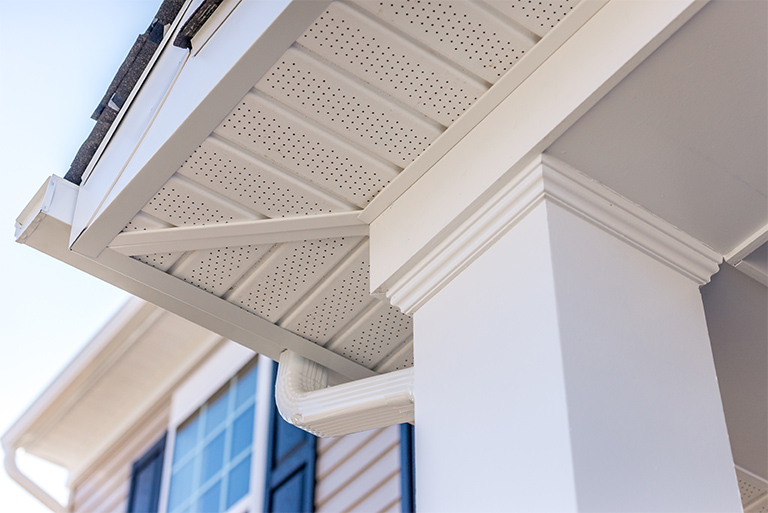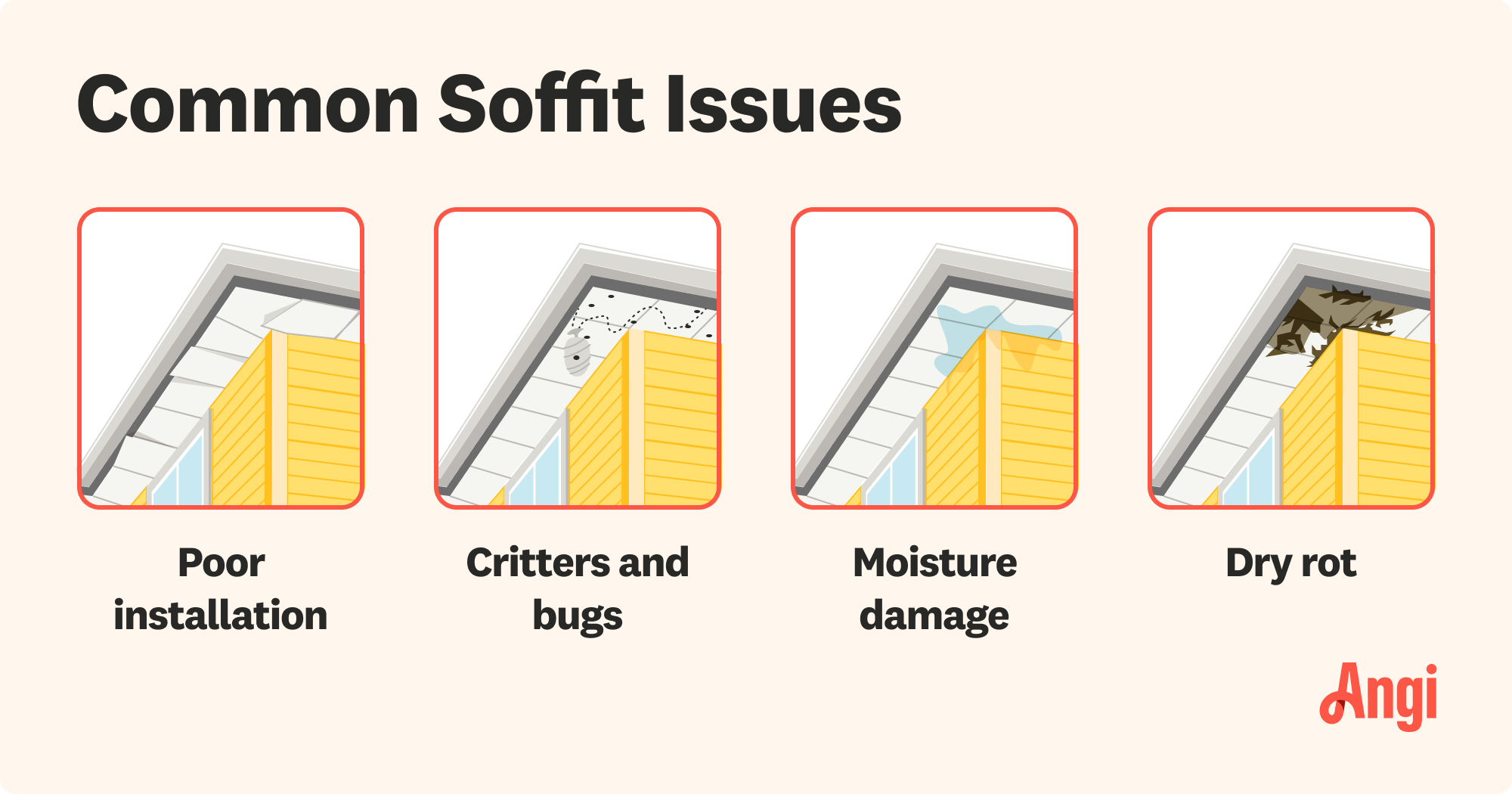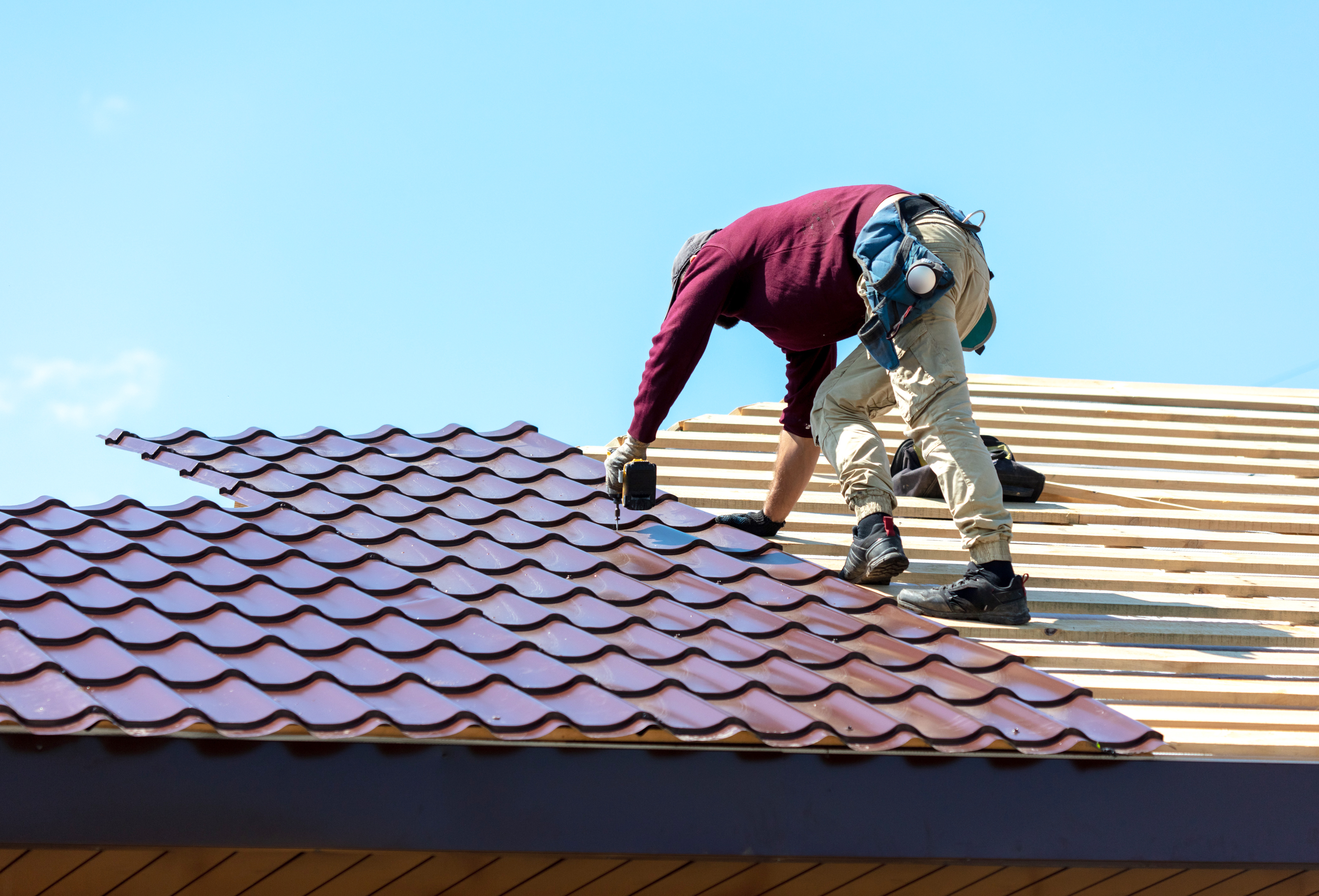
Learn about average roof repair costs in New York City and what factors can affect your total to set your budget appropriately.
Learn to identify and fix common roofing issues before they become more expensive problems


The most common soffit issues include pest infestations, moisture damage, and dry rot.
Most fascia boards are wood, which can decay over time.
On average, soffit and fascia repairs cost between $6 and $20 per linear foot.
A roof is actually pretty complex, with a variety of parts and components that work together to increase ventilation, provide protection, and improve the overall aesthetics of your home.
Two often misunderstood roofing components are the soffit and the fascia. And while both are vital parts of your home, they can contribute to some common roofing problems which may need professional repair.
The word soffit derives from the French word for "formed as a ceiling" and the Latin term for "to fix underneath." The soffit can refer to the horizontal underside of an archway, a staircase, or a ceiling, but it typically refers to an exposed surface beneath the hanging section of a roof eave.
Part of the soffit’s function is to help ventilate the attic. The soffit typically features a plain design with small holes that provide air circulation. The air from the soffit cycles to the vents to draw heat and moisture away from the house. This is a highly important function because moisture in the attic can cause rot in the sheathing and rafters.
Vinyl is the most popular material for soffits, as it minimizes degradation that comes from heat and moisture exposure. This is especially important considering that the soffit can be easily exposed to moisture due to unkempt gutters and wet weather conditions.
If you’re looking to build a new home, choose a soffit with vinyl as its primary material. Vinyl is both water-resistant and cost-effective and can save you energy because it is highly efficient when it comes to regulating a home’s temperature.

As important as it is, the soffit can fall victim to a number of issues. Tackle them by hiring a soffit repair professional or by putting on your DIY hat.
Soffits can be tricky to install, and an improper installation could lead to a host of serious problems. If the soffits have been incorrectly placed, they could be vulnerable to wind damage and related weather conditions. If the soffits are too close together, they may not properly ventilate your home.
A reputable roof inspector can conduct a roof inspection and give the soffits a good look to see if they have been properly installed.
Birds, small rodents, bees, wasps, and a variety of other unwelcome guests can make their home in the spaces between the eaves. These same pests can use the soffits to gain access to the attic.
Conduct a spot check in your attic for tell-tale signs of an infestation and look at the soffits themselves. Are they spaced properly? Are there small holes or cracks that insects could make a home in? Seal up any holes or cracks with caulk or mesh and contact a professional exterminator near you if needed.
Soffits can experience moisture damage, as they are typically located next to the gutters. Wooden soffits are especially vulnerable, which is one of the primary reasons modern consumers tend to go with vinyl soffits.
You can prevent water damage by making it a point to clean the soffits when you clean the gutters. If you notice some telltale signs of moisture damage, such as blisters and cracks, repaint them as soon as possible. If the water damage has compromised the structural integrity of the soffits, you may need to contact a qualified pro.
Contrary to popular belief, dry rot is not actually caused by an abundance of moisture damage, but by certain types of fungus that thrive on wood fiber. Dry rot typically starts on wood siding but can easily spread to the soffit.
Check for dry rot by grabbing a large screwdriver or similar tool and tapping the soffit gently but firmly. If pieces immediately fall out, you likely have dry rot and should contact a professional to replace the soffit.

The fascia is a vertical finishing edge connected to the area where the gutter attaches to the roof, though it can also be found connected to the rafters or trusses. The fascia’s primary role is to act as a layer between the roof’s edge and the outdoors, and it’s meant to protect the wooden board from water damage.
Aside from its functional role, the fascia also plays a very important aesthetic role, creating a smoother, more even appearance for the roof’s edge. In addition to protecting the wooden board from water damage, the fascia protects the entire roof and the house’s interior from weather damage by blocking water from the home. Most homes feature a fascia board, but some older home styles lack this component.
Just like its soffit cousin, the fascia board can experience a wide range of issues that may need repair.
Most fascia boards are wood, and this wood can decay over time. Protect your wooden boards from decay by regularly painting them with a high-grade primer and covering up any obvious cracks and holes. You can also consider a fascia cap, otherwise known as fascia trim, which is a durable covering placed around the fascia board made from aluminum and other hearty materials.
If a fascia board experiences significant decay, you may have to replace it. Fortunately, this is a fairly straightforward process and considered part of normal roof maintenance. You can also learn how to replace fascia boards yourself, even if you don’t know how to replace a roof, to save some money on labor fees. Replacement typically entails removing the old board and putting in a new one that has been cut to length. After you have installed the replacement fascia board, seal the joints and paint it.
But there are a number of considerations when choosing the right fascia board for your home. Make sure you pick the best wood for your climate. When in doubt, cedar heartwood and cypress are good options for most environments. You should also opt for fascia boards with grain structures that are resistant to splitting, twisting, warping, and bowing.
The type of nails you use will also impact the longevity of a fascia board. Your best bet will be either stainless steel or old-fashioned, hot-dipped galvanized nails, as each nail type is incredibly durable.
If you notice signs that your soffit and fascia materials are damaged or degrading, the good news is that they can often be fixed without the need for a full roof replacement or knowing how to install metal roofing or other roofing materials.
You can hire a professional to repair soffit and fascia, or you can learn how to do the repair yourself. Just make sure to take proper precautions to complete the job safely. If you’re not well versed in roof repair, it’s best to call in a pro. Most roofing companies can repair or replace soffit and fascia materials; get a few quotes to make sure you’re getting a good price and hiring a local roof repair company you’re comfortable with.
| Soffit and Fascia Material | Average Cost for Fascia Repair (Per Linear Foot) | Average Cost for Soffit Repair (Per 12-Foot Sections) |
|---|---|---|
| Wood | $1–$3 | $14–$22 |
| Vinyl | $5–$8 | $14–$23 |
| Composite | $2–$8 | $12–$20 |
| Aluminum | $8–$20 | $10–$22 |
Soffit and fascia repairs likely won’t be as much as a full roof replacement cost, and they can extend the life of your roof, so it’s a good idea to get a few estimates. On average, soffit and fascia repair costs between $6 and $20 per linear foot and depends on the material you choose, the cost of labor, the presence of insects and pests, and the eave configuration.
If you’re replacing the soffit and fascia as part of a full roof replacement, the final number will depend on the size and shape of the roof and the material you use, since asphalt, slate, composite, and metal roof cost differs.
Lawrence Bonk contributed to this piece.
Exceptional quality of work, customer satisfaction oriented. I wanted to do interior work and was so impressed I asked for shingle roof and siding work on my home also, which came out very great. Any questions and concerns, Galaxy contractor answered my questions. Thank you guys.
JI roofing performed a complete roof replacement on our home, which included installation of a GAF certified roof with intake vents, new gutters, and two new bathroom exhaust fans. They did an amazing job on many levels: a) the craftsmanship was superb (our next door neighbor said we now have...
Top Royal Construction is a great roofing company. This company was very professional during this transaction. There were no hidden agendas, just a work of excellence. This was my second time purchasing a roof from Top Royal. The estimate and the work performed is very rare. I highly...
All Complete Construction is very professional and helpful roof company. They care about what they do and provide excellent customer service. Sam is the great person. Their office staff was super positive, helpful and attentive. Wouldn t hesitate to call them again when we need roof chimney...
I received the perfect roofing service from Top Roof Contractor. It has been very pleasurable experience working with the guys. I would like to thank them here as well for the amazing job they have done with replacing the roof of my house!! Thanks
I've been wanting to have my home redecorated and I wanted to start with my front lawn. They had great ideas of putting in a new kind of landscaping design and concrete curbs. Great service and very creative team!
I needed a kitchen and bathroom remodeling and these guys were the best people I could choose. They took my vision and brought it to life! Amazing customer service.
Excellent overall, very efficient and professional. The owner Chuck addressed an issue immediately after the roof was installed. Would highly recommend.
Efficient, timely and very professional I would highly recommend them
Professional, courteous and great quality. Would hire the team again.
From average costs to expert advice, get all the answers you need to get your job done.

Learn about average roof repair costs in New York City and what factors can affect your total to set your budget appropriately.

A new roof boosts curb appeal and home value and keeps your property protected. Learn about roof replacement costs in New York City to budget accurately.

Need a new roof in the city that never sleeps? Learn about metal roof costs in New York to see if this durable roofing material is within your budget.

Understanding roof rafter sizes is critical to ensure your project is structurally sound and up to code. Learn about sizes, spacing, and code requirements.

Shingles that are losing their granules may not be protecting your roof. Learn why shingle granule loss happens and what it means for your roof.

A leaky roof is less than ideal. Learn how to patch a roof while you wait for repairs from the pros to prevent further damage to your home.